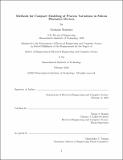| dc.contributor.advisor | Duane S. Boning. | en_US |
| dc.contributor.author | Martinez, Germain | en_US |
| dc.contributor.other | Massachusetts Institute of Technology. Department of Electrical Engineering and Computer Science. | en_US |
| dc.date.accessioned | 2018-12-11T20:40:26Z | |
| dc.date.available | 2018-12-11T20:40:26Z | |
| dc.date.copyright | 2018 | en_US |
| dc.date.issued | 2018 | en_US |
| dc.identifier.uri | http://hdl.handle.net/1721.1/119567 | |
| dc.description | Thesis: M. Eng., Massachusetts Institute of Technology, Department of Electrical Engineering and Computer Science, 2018. | en_US |
| dc.description | This electronic version was submitted by the student author. The certified thesis is available in the Institute Archives and Special Collections. | en_US |
| dc.description | Cataloged from student-submitted PDF version of thesis. | en_US |
| dc.description | Includes bibliographical references (pages 123-127). | en_US |
| dc.description.abstract | Photonic systems are being developed with extensions to existing CMOS processes, and are growing in complexity. Silicon photonics designs are evaluated in simulation using similar methods to those used for CMOS transistor and circuit designs; simulation models for common silicon-based photonics structures and devices currently exist and are used to design larger photonic systems. However, these photonics models are often not constructed with manufacturing variations in mind. This thesis presents methods for creating simulation models for nanophotonic devices that take systematic and random variations from manufacturing into account. Factorial experiment design is used to explore the eect of process variations on photonic device performance. Corner models are constructed using the results from experiment design and capture worst-case variations. The response surface modeling method is employed to develop parameterized compact models. Example variation-aware compact models are generated using these methods for the directional coupler and the Y-branch, two passive devices widely used in silicon photonics. The use of these models is demonstrated through corner and statistical variation analyses of a simple Mach-Zehnder interferometer photonic circuit composed of the directional coupler and Y-branch devices. | en_US |
| dc.description.statementofresponsibility | by Germain Martinez. | en_US |
| dc.format.extent | 127 pages | en_US |
| dc.language.iso | eng | en_US |
| dc.publisher | Massachusetts Institute of Technology | en_US |
| dc.rights | MIT theses are protected by copyright. They may be viewed, downloaded, or printed from this source but further reproduction or distribution in any format is prohibited without written permission. | en_US |
| dc.rights.uri | http://dspace.mit.edu/handle/1721.1/7582 | en_US |
| dc.subject | Electrical Engineering and Computer Science. | en_US |
| dc.title | Methods for compact modeling of process variations in silicon photonics devices | en_US |
| dc.type | Thesis | en_US |
| dc.description.degree | M. Eng. | en_US |
| dc.contributor.department | Massachusetts Institute of Technology. Department of Electrical Engineering and Computer Science | |
| dc.identifier.oclc | 1076274956 | en_US |
